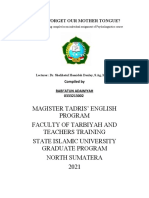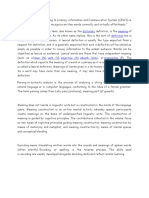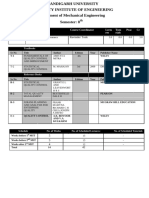0 ratings0% found this document useful (0 votes)
156 viewsBilingualism
Bilingualism
Uploaded by
Faizal BluesThe document discusses bilingualism, multilingualism, and plurilingualism. It defines bilingualism as the ability to use two languages, not necessarily equally well, and multilingualism as the ability to use several languages through interaction and experience. Plurilingualism refers to using one's combined language skills and knowledge to communicate in various situations. The document also discusses psycholinguistics, the study of how humans acquire and use language, and questions whether aspects like language mixing, cognitive effects, and ease of learning differ between mono- and multi-lingual individuals. It provides a short quiz on topics in language acquisition.
Copyright:
© All Rights Reserved
Available Formats
Download as DOC, PDF, TXT or read online from Scribd
Bilingualism
Bilingualism
Uploaded by
Faizal Blues0 ratings0% found this document useful (0 votes)
156 views2 pagesThe document discusses bilingualism, multilingualism, and plurilingualism. It defines bilingualism as the ability to use two languages, not necessarily equally well, and multilingualism as the ability to use several languages through interaction and experience. Plurilingualism refers to using one's combined language skills and knowledge to communicate in various situations. The document also discusses psycholinguistics, the study of how humans acquire and use language, and questions whether aspects like language mixing, cognitive effects, and ease of learning differ between mono- and multi-lingual individuals. It provides a short quiz on topics in language acquisition.
Original Title
Bilingualism.doc
Copyright
© © All Rights Reserved
Available Formats
DOC, PDF, TXT or read online from Scribd
Share this document
Did you find this document useful?
Is this content inappropriate?
The document discusses bilingualism, multilingualism, and plurilingualism. It defines bilingualism as the ability to use two languages, not necessarily equally well, and multilingualism as the ability to use several languages through interaction and experience. Plurilingualism refers to using one's combined language skills and knowledge to communicate in various situations. The document also discusses psycholinguistics, the study of how humans acquire and use language, and questions whether aspects like language mixing, cognitive effects, and ease of learning differ between mono- and multi-lingual individuals. It provides a short quiz on topics in language acquisition.
Copyright:
© All Rights Reserved
Available Formats
Download as DOC, PDF, TXT or read online from Scribd
Download as doc, pdf, or txt
0 ratings0% found this document useful (0 votes)
156 views2 pagesBilingualism
Bilingualism
Uploaded by
Faizal BluesThe document discusses bilingualism, multilingualism, and plurilingualism. It defines bilingualism as the ability to use two languages, not necessarily equally well, and multilingualism as the ability to use several languages through interaction and experience. Plurilingualism refers to using one's combined language skills and knowledge to communicate in various situations. The document also discusses psycholinguistics, the study of how humans acquire and use language, and questions whether aspects like language mixing, cognitive effects, and ease of learning differ between mono- and multi-lingual individuals. It provides a short quiz on topics in language acquisition.
Copyright:
© All Rights Reserved
Available Formats
Download as DOC, PDF, TXT or read online from Scribd
Download as doc, pdf, or txt
You are on page 1of 2
Bilingualism, multilingualism, plurilingualism
The knowledge of several languages is nowadays indispensable for university
education, cultural and social life, and it often becomes the prerequisite for
employment. EU documents state that a contemporary European should be multior plurilingual. What does it actually mean? You can learn more about it from our
courses on acquisition, learning and teaching of languages.
Who is bilingual or multilingual?
A bilingual is not a person who knows two languages equally well. Such people are
rare. Bilingualism is defined asthe ability to build understandable utterances in
any of the languages known. So, language learners are also considered bilingual.
Multilingualism is theability to use several languages (not perfectly well),
assuming a mutual interaction of languages in the mind of the user, as well as the
bulk of linguistic and cultural experience of the user which add to his/her
communicative competence. Such a way of understanding multilingualism is
connected with the notion ofplurilingualism, used in EU documents.
Plurilingualism does not mean a perfect command of several languages but the
attempt to use ones linguistic knowledge and skills to communicate with others in
many different situations. In practice, it means the ability to effectively function in a
multinational and multicultural community thanks to a sensitivity to similarities and
differences between languages and cultures.
Psycholinguistics a domain on the crossroads
Can you measure and describe the acquisition of a first language by children? Can
you measure the learning of foreign languages? You will find answers to such
questions during our psycholinguistic courses. This is a domain of study on the
crossroads of psychology and linguistics which deals with the psychological bases of
linguistic functioning, i.e. how languages are acquired, processed, and used by
human beings.
So, a short test for those interested:
Is it possible that a child with normal IQ will never acquire his/her native
language?
Yes, if he/she does not start at the right moment, i.e. is isolated from language
stimuli till the age of puberty.
Do bilingual children acquiring two languages simultaneously develop
similarly to their monolingual peers?
No, in the first years of life their acquisition of both languages may be delayed.
They have a double task to do, so they need more time to learn.
Are the languages of bilinguals and multilinguals mixed in their heads?
Yes, languages are not stored in separate boxes in the mind. But bi- and
multilinguals can largely control their languages and actively inhibit the use of the
language they do not need at the time. Language mixing also has an impact on
the easiness of learning consecutive languages.
Do bi- and multilinguals differ from monolinguals?
Yes, the knowledge of languages influences the flexibility of our brain (e.g. inhibitory
processes) and our cognitive abilities.
Does bilingualism influence the way we perceive the world?
Yes, language knowledge may change the way we name objects, or perceive colours
and spatial relations.
Do we learn another language differently than the first?
It depends on our age and on the circumstances (How old are you? Are you learning
in class or in a natural setting?).
Can a Polish person learn any language with equal ease?
No, it is easier to learn languages which are typologically closer, so for us it would
be Slovak rather than Norwegian.
Interesting? Such issues are discussed during courses dealing with
psycholinguistics and language acquisition. We offer courses on:
language acquisition
learning language systems and skills
individual differences in language learning
native language influence on language acquisition
psychology of communication
Methodology of language teaching
You are bilingual or multilingual. So you can teach other languages. If you want to
know:
why there is no point in explaining grammar to children,
how to cope with a class of eight-year olds,
how to entertain teenagers,
if a good language teacher should know other languages,
where to look for materials for your lessons,
we offer numerous courses on ELT methodology dealing with:
modern methods of English language teaching
the analysis and creation of teaching materials
language testing
You might also like
- O&M Manual PDFDocument100 pagesO&M Manual PDFFikret DavudovNo ratings yet
- Tema 2. Teorías Generales Sobre El Aprendizaje Y La Adquisición de Una Lengua Extranjera. El Concepto de Interlengua. El Tratamiento Del ErrorDocument12 pagesTema 2. Teorías Generales Sobre El Aprendizaje Y La Adquisición de Una Lengua Extranjera. El Concepto de Interlengua. El Tratamiento Del ErrorJose S HerediaNo ratings yet
- Les notes de Polyglotte. Conseils pratiques pour l'apprentissage d'une langue étrangère.From EverandLes notes de Polyglotte. Conseils pratiques pour l'apprentissage d'une langue étrangère.Rating: 5 out of 5 stars5/5 (3)
- Arteriovenous Malformation (AVM) : Signs and SymptomsDocument7 pagesArteriovenous Malformation (AVM) : Signs and SymptomsCj UritaNo ratings yet
- Can We Forget Our Mother TongueDocument11 pagesCan We Forget Our Mother TongueLuthfy HamizanNo ratings yet
- Makalah SosioDocument4 pagesMakalah SosioSaiful HudaNo ratings yet
- CULTUREDocument5 pagesCULTURESheryn AstibeNo ratings yet
- Language Awareness Section CombinedDocument40 pagesLanguage Awareness Section CombinedSubhasiny AnathanNo ratings yet
- The Nature of SLADocument10 pagesThe Nature of SLAHakimHasn'tAlbanaNo ratings yet
- Teaching English in The Elementary Grades: Community College of Manito Manito, Albay A.Y.: 2020-2021Document7 pagesTeaching English in The Elementary Grades: Community College of Manito Manito, Albay A.Y.: 2020-2021Juliet ArdalesNo ratings yet
- Bilingualism and MultilingualismDocument10 pagesBilingualism and MultilingualismSubham PandeyNo ratings yet
- Bilingualism and Second Language AcquisitionDocument5 pagesBilingualism and Second Language AcquisitionGilberto MaldonadoNo ratings yet
- MTBMLEDocument7 pagesMTBMLEApril RoseNo ratings yet
- What Is Monolingual Situation? Monolingual Assigns To SomeoneDocument3 pagesWhat Is Monolingual Situation? Monolingual Assigns To SomeoneNazik HussainNo ratings yet
- Defining First Language AcquisitionDocument6 pagesDefining First Language AcquisitionJuliet Ardales100% (1)
- Module 3 - Lesson 2 - Branches of LinguisticsDocument9 pagesModule 3 - Lesson 2 - Branches of LinguisticsMarielle Eunice ManalastasNo ratings yet
- Child Language Acquisition and Bilingualism HandoutDocument5 pagesChild Language Acquisition and Bilingualism HandoutCharize Anne MendozaNo ratings yet
- 2 - General Theories About Learning and Acquisition of A Foreign LanguageDocument5 pages2 - General Theories About Learning and Acquisition of A Foreign LanguageRobertoNo ratings yet
- Myths About - LanguageDocument5 pagesMyths About - LanguageJim CabezasNo ratings yet
- Benefits of BilingualismDocument2 pagesBenefits of BilingualismAtif HaiderNo ratings yet
- Chaper 1. The Bilingual Edge en-GBDocument3 pagesChaper 1. The Bilingual Edge en-GBMARIA FERNANDEZNo ratings yet
- What Is Linguistic and Why Do We Study ItDocument3 pagesWhat Is Linguistic and Why Do We Study ItVeronica OguilveNo ratings yet
- Foundations of Second Language AcquisitionDocument14 pagesFoundations of Second Language AcquisitionaciNo ratings yet
- BILINGUALISMDocument40 pagesBILINGUALISMdejesussofia9No ratings yet
- Module 5 - Language DevelopmentDocument3 pagesModule 5 - Language Developmentyusijusmine21No ratings yet
- 6 Contributions of LinguisticsDocument4 pages6 Contributions of LinguisticsTeresa Pajarón LacaveNo ratings yet
- Language Across The CurriculumDocument3 pagesLanguage Across The CurriculumdzedziphillyNo ratings yet
- Makalah Applied LinguisticsDocument7 pagesMakalah Applied Linguisticsdimas oktarinoNo ratings yet
- TEFL Lec1Document22 pagesTEFL Lec1Syed IhtishamNo ratings yet
- The Origins of Lithuanian Languge. The Uniqueness and Fascinating Facts About ItDocument5 pagesThe Origins of Lithuanian Languge. The Uniqueness and Fascinating Facts About ItDeimante BungaiteNo ratings yet
- Psycholinguistics NotesDocument17 pagesPsycholinguistics NotesMARTIN AYONo ratings yet
- English Asl ProjectDocument22 pagesEnglish Asl Projectdivyanshpratapsingh1121No ratings yet
- Modern Grammar Development in The English LanguageDocument13 pagesModern Grammar Development in The English LanguageKarina Yesenia Salinas0% (1)
- Intro To LinguisticsDocument33 pagesIntro To Linguisticsrubi.uribediazNo ratings yet
- Why Major in Linguistics (And What Does A Linguist Do) ?, by Monica Macaulay and Kristen SyrettDocument4 pagesWhy Major in Linguistics (And What Does A Linguist Do) ?, by Monica Macaulay and Kristen SyrettozukecaloNo ratings yet
- Simple Notes On LifeDocument54 pagesSimple Notes On LifeCzarina GenteroyNo ratings yet
- Why Major in Linguistics 0815Document4 pagesWhy Major in Linguistics 0815George J. XydopoulosNo ratings yet
- Multilingual Is MDocument6 pagesMultilingual Is MHelenNo ratings yet
- Mid Test PsycholinguisticsDocument4 pagesMid Test Psycholinguisticsnurul rifaaNo ratings yet
- Tema 2Document13 pagesTema 2Patricia GarciaNo ratings yet
- Questions About The ArticleDocument4 pagesQuestions About The ArticleInma RdNo ratings yet
- Immersion ClassDocument6 pagesImmersion ClassAditya Chandra PrasetiaNo ratings yet
- Material 1 in Content and Pedagogy 1Document6 pagesMaterial 1 in Content and Pedagogy 1Ronela MansanadeNo ratings yet
- DEI - Young LearnersDocument11 pagesDEI - Young LearnersRoxana AndreaNo ratings yet
- English Unit 1Document12 pagesEnglish Unit 1ASWIN SNo ratings yet
- BilingualismDocument5 pagesBilingualismAlushka OthmanNo ratings yet
- LACDocument91 pagesLACriyathansatNo ratings yet
- CHAPTER 1 - Understanding LanguageDocument15 pagesCHAPTER 1 - Understanding LanguageDenis MoralesNo ratings yet
- LanguageDocument30 pagesLanguageAluko WemimoNo ratings yet
- Languge Programs and Policies in Multilingual Societies Lesson 1 9Document87 pagesLanguge Programs and Policies in Multilingual Societies Lesson 1 9Lucas XiiNo ratings yet
- Final Test NotesDocument8 pagesFinal Test NotesidiazNo ratings yet
- El104 Final Content (Arciga, Rhea Mae)Document2 pagesEl104 Final Content (Arciga, Rhea Mae)Rhea Mae ArcigaNo ratings yet
- BilingualsDocument6 pagesBilingualsMeguel Baisac EcoNo ratings yet
- IntroductionDocument16 pagesIntroductionChandrajit ZalaNo ratings yet
- EL101 - Module 1Document8 pagesEL101 - Module 1jhna mggy0% (1)
- Chapter OneDocument14 pagesChapter OnemiranjehanNo ratings yet
- Chapter 14 - 2nd Language Acquisition LinguisticsDocument9 pagesChapter 14 - 2nd Language Acquisition LinguisticsVictor Ariel TolozaNo ratings yet
- Assignment 2 Write An Essay On The SeconDocument6 pagesAssignment 2 Write An Essay On The SeconMohamed BdiouiNo ratings yet
- TASK 1. What Are The Benefits of Bilingualism and Multilingualism PDFDocument3 pagesTASK 1. What Are The Benefits of Bilingualism and Multilingualism PDFNuria VallsNo ratings yet
- Compassionate Educational Practices in Language LearningFrom EverandCompassionate Educational Practices in Language LearningNo ratings yet
- How to Become a Polyglot: A Step-by-Step Guide to Successfully Learning a New Language and Expanding Your OpportunitiesFrom EverandHow to Become a Polyglot: A Step-by-Step Guide to Successfully Learning a New Language and Expanding Your OpportunitiesNo ratings yet
- Lesson PlanDocument1 pageLesson PlanFaizal BluesNo ratings yet
- BilingualismDocument2 pagesBilingualismFaizal BluesNo ratings yet
- Word RecognitionDocument1 pageWord RecognitionFaizal BluesNo ratings yet
- Bahasa Inggeris Tahun 1Document9 pagesBahasa Inggeris Tahun 1Faizal Blues100% (1)
- SPM SemakDocument1 pageSPM SemakFaizal BluesNo ratings yet
- 70-698 Lesson07Document23 pages70-698 Lesson07Ramandeep kaurNo ratings yet
- Foundation DetailDocument1 pageFoundation DetailDEVCHADDHANo ratings yet
- Manufacturing SOP Compliance Template ChecklistDocument3 pagesManufacturing SOP Compliance Template ChecklistzakariaNo ratings yet
- Grade 4 - Time ExpressionsDocument13 pagesGrade 4 - Time ExpressionsladyNo ratings yet
- SAG - Housekeeping NC IIIDocument7 pagesSAG - Housekeeping NC IIImiles1280No ratings yet
- Values in Evaluation - The Use of RubricsDocument4 pagesValues in Evaluation - The Use of RubricssantimosNo ratings yet
- Design of Glass BalustradeDocument17 pagesDesign of Glass BalustradeNp PwNo ratings yet
- 10,11 QCA Lect. PlanDocument14 pages10,11 QCA Lect. Planerravinder.tonkNo ratings yet
- Porsche Financial Services BrochureDocument8 pagesPorsche Financial Services BrochureAndre BarnesNo ratings yet
- Power Information Technology Company (PITC) Customer Data SummaryDocument8 pagesPower Information Technology Company (PITC) Customer Data SummaryUmeshNo ratings yet
- HTTP Pportal - PunjabDocument3 pagesHTTP Pportal - Punjabnaeem313100% (1)
- Basic Hebrew VocabularyDocument15 pagesBasic Hebrew VocabularyScribdTranslationsNo ratings yet
- Driving Test Slot ConfirmationDocument3 pagesDriving Test Slot ConfirmationSudeep JasonNo ratings yet
- ÉSECÈ Group - Steam Boiler - Mar12 ENGDocument4 pagesÉSECÈ Group - Steam Boiler - Mar12 ENGDiego Otero Rodríguez100% (1)
- Geography Grade 6 1.1Document73 pagesGeography Grade 6 1.1Enkeleda Cavolli Sinjari100% (1)
- Normal Random Variable and Its CharacteristicsDocument26 pagesNormal Random Variable and Its CharacteristicsburnitrinNo ratings yet
- LK 90C ImpregnationDocument2 pagesLK 90C ImpregnationTrầnCôngĐuaNo ratings yet
- Copyright Page Dissertation ExampleDocument4 pagesCopyright Page Dissertation ExampleBuyAPaperOnlineSingapore100% (1)
- Jammu and Kashmir Control of Building Operations Act, 1988Document15 pagesJammu and Kashmir Control of Building Operations Act, 1988Jer RyNo ratings yet
- Artificer: ProficiencyDocument1 pageArtificer: ProficiencyKieran TurtleNo ratings yet
- Patent MethanolDocument12 pagesPatent MethanolBahrulUlumNo ratings yet
- Global Mining Brochure 2Document18 pagesGlobal Mining Brochure 2Paolo VelcichNo ratings yet
- Product Codes-Made in ChinaDocument3 pagesProduct Codes-Made in ChinaMaimai AnievasNo ratings yet
- What Is Business'Document61 pagesWhat Is Business'Avirup BiswasNo ratings yet
- PH L C 5 - BILL OF LADINGDocument1 pagePH L C 5 - BILL OF LADINGNgân DươngNo ratings yet
- Freaky Weasel Marketing PlanDocument14 pagesFreaky Weasel Marketing PlanAndrew RogersNo ratings yet
- 2020 Mod ListDocument18 pages2020 Mod Listdenilson araujo100% (1)
- Red Hat Enterprise Linux-7-Windows Integration Guide-En-USDocument120 pagesRed Hat Enterprise Linux-7-Windows Integration Guide-En-USgfd953845No ratings yet






























































































